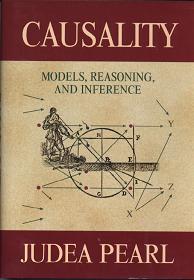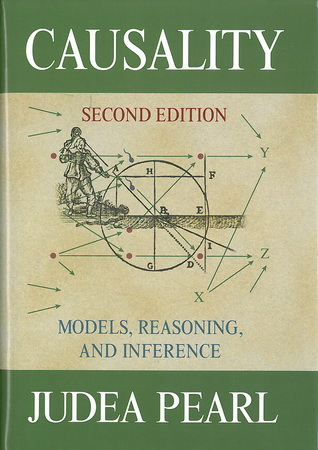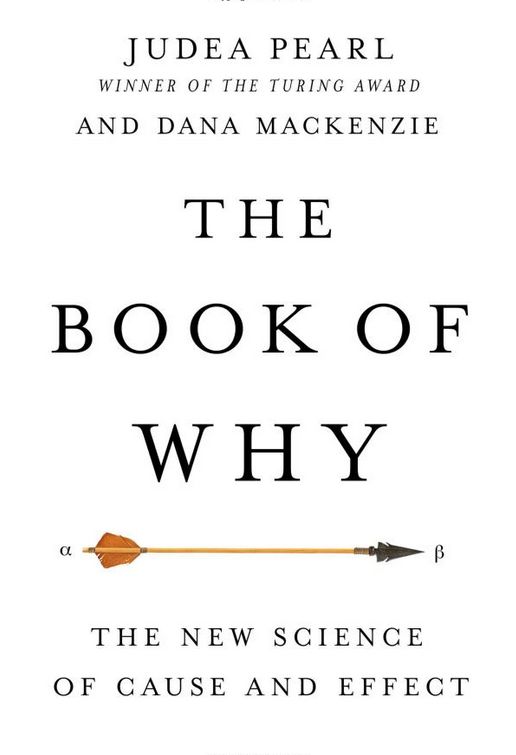Judea Pearl's new book, The Book of Why, is a must read for anyone interested in philosophy, science, machine learning or statistics. — Milo Schield, Editor
Judea Pearl website List of papers
The Book of Why: The New Science of Cause and Effect
Summary and TOC Index Pearl's update
Causality (2nd ed) website:
- Why I wrote this book
- Table of Contents
- Preface
- Preview of text Important Topic: On the meaning of structural equations (from Causality, Sections 5.3.2 - 5.4.1)
- Reviews
- Discussion with readers
- Viewgraphs and homework for instructors
-
Recent seminars
- video from a UCLA seminar on the state of causality in economics
- video from a seminar given at John Hopkins University
- video from a seminar given at ISI
- video of lecture on causes and counterfactuals
- Lakatos Award for 2001
- Excerpts from the 2nd edition of Causality
An Introduction to Causal Inference
February 8, 2015
The Art and Science of Cause and Effect
Transcript and slides of 1996 Faculty Research Lecture
Reasoning with Cause and Effect
Transcript and slides of 1999 IJCAI Award Lecture
Understanding Simpson’s Paradox (2014)
The American Statistician, February 2014, Vol. 68, No. 1.
Simpson’s paradox is often presented as a compelling demonstration of why we need statistics education in our schools. It is a reminder of how easy it is to fall into a web of paradoxical conclusions when relying solely on intuition, unaided by rigorous statistical methods. In recent years, ironically, the paradox assumed an added dimension when educators began using it to demonstrate the limits of statistical methods, and why causal, rather than statistical considerations are necessary to avoid those paradoxical conclusions (Wasserman 2004; Arah 2008; Pearl 2009, pp. 173–182).
My comments are divided into three parts. First, I will give a brief summary of the history of Simpson’s paradox and how it has been treated in the statistical literature in the past century. Next, I will ask what is required to declare the paradox “resolved,” and argue that modern understanding of causal inference has met those requirements. Finally, I will answer specific questions raised in Armistead’s article and show how the resolution of Simpson’s paradox can be taught for fun and progress.
The Causal Mediation Formula — A Guide to the Assessment of Pathways and Mechanisms (2012)
Abstract:
“Recent advances in causal inference have given rise to a general and easy-to-use formula for assessing the extent to which the effect of one variable on another is mediated by a third. This Mediation Formula is applicable to nonlinear models with both discrete and continuous variables, and permits the evaluation of path-specific effects with minimal assumptions regarding the data-generating process. We demonstrate the use of the Mediation Formula in simple examples and illustrate why parametric methods of analysis yield distorted results, even when parameters are known precisely. We stress the importance of distinguishing between the necessary and sufficient interpretations of ‘mediated-effect’ and show how to estimate the two components in nonlinear systems with continuous and categorical variables.”
Keywords and phrases:
Effect decomposition, direct and indirect effects, structural equation models, percentage explained, moderation
Contents:
- Introduction
- Total, direct and indirect effects
- The Mediation Formula: A Simple Solution to a Thorny Problem
- Relations to Traditional Approaches
- Conclusions
Excerpts:
“Consider a randomized clinical trial in which an intervention X shows a significant effect on an outcome Y. A question that invariably comes to investigators’ minds is: How and why does the intervention produce the effect, or, more specifically, can the effect of X on Y be attributed to its effect on some intermediate variable Z standing between the two?”
A. M. Turing Award Winner: 2011
“For fundamental contributions to artificial intelligence through the development of a calculus for probabilistic and causal reasoning.” Video.
Statistics and Causality: Separated to Reunite (2011)
Commentary on Bryan Dowd’s “Separated at Birth”
Excerpt:
“I see the tension between statistics and economics or, more generally, between statistics and causality, to be rooted in a more fundamental schism than the one portrayed in Dowd’s account. Moreover, and contrary to Dowd’s narrative, I believe that the schism was justified, necessary, and not sufficiently emphasized. In fact, it was only after the distinction between statistical and causal concepts was made crisp and formal through new mathematical notation that a productive symbiosis has emerged which now benefits both paradigms.”
Conclusion:
“Causal and statistical information are two different species that do not and should not be mixed. The latter deals with probabilistic relationships among observed variables; the former deals with hypothetical relationships in new situations. These relationships should be kept apart by notational distinctions and be governed by separate calculi. Once the mathematical distinction is accomplished, symbiotic analysis can benefit both causal and statistical inferences.”
Causal Inference in Statistics: An overview (2009)
Abstract:
This review presents empirical researchers with recent advances in causal inference, and stresses the paradigmatic shifts that must be undertaken in moving from traditional statistical analysis to causal analysis of multivariate data. Special emphasis is placed on the assumptions that underly all causal inferences, the languages used in formulating those assumptions, the conditional nature of all causal and counterfactual claims, and the methods that have been developed for the assessment of such claims. These advances are illustrated using a general theory of causation based on the Structural Causal Model (SCM) described in Pearl (2000a), which subsumes and unifies other approaches to causation, and provides a coherent mathematical foundation for the analysis of causes and counterfactuals. In particular, the paper surveys the development of mathematical tools for inferring (from a combination of data and assumptions) answers to three types of causal queries: (1) queries about the effects of potential interventions, (also called “causal effects” or “policy evaluation” ) (2) queries about probabilities of counterfactuals, (including assessment of “regret,” “attribution” or “causes of effects”) and (3) queries about direct and indirect effects (also known as “mediation”). Finally, the paper defines the formal and conceptual relationships between the structural and potential-outcome frameworks and presents tools for a symbiotic analysis that uses the strong features of both.
Keywords and phrases:
Structural equation models, confounding, graphical methods, counterfactuals, causal effects, potential outcome, mediation, policy evaluation, causes of effects
Contents:
- Introduction
- From association to causation
- Structural models, diagrams, causal effects, and counterfactuals
- The potential outcome framework
- Counterfactuals at work
- Conclusions
Excerpts:
“The questions that motivate most studies in the health, social and behavioral sciences are not associational but causal in nature.” “although much of the conceptual framework and algorithmic tools needed for tackling such problems are now well established, they are hardly known to researchers who could put them into practical use. The main reason is educational.”
“A useful demarcation line that makes the distinction between associational and causal concepts crisp and easy to apply, can be formulated as follows. An associational concept is any relationship that can be defined in terms of a joint distribution of observed variables, and a causal concept is any relationship that cannot be defined from the distribution alone. Examples of associational concepts are: correlation, regression, dependence, conditional independence, likelihood, collapsibility, propensity score, risk ratio, odds ratio, marginalization, conditionalization, ‘controlling for,’ and so on. Examples of causal concepts are: randomization, influence, effect, confounding, ‘holding constant,’ disturbance, spurious correlation, faithfulness/stability, instrumental variables, intervention, explanation, attribution, and so on. The former can, while the latter cannot be defined in term of distribution functions.”
Simpson's Paradox: An Anatomy (1999)
This report discusses the reversal effect known as Simpson's paradox from a causal-theoretic viewpoint. It analyzes the reasons why the effect has been (and still is) considered paradoxical and why its resolution has been so late in coming. The report is extracted from a forthcoming book, Causality [Pearl, 2000] and assumes some familiarity with causal diagrams and the dot (.) (or set (.)) notation (e.g., [Pearl 1995]).




